
Vol. 6, No.3, March 2010 |
 Printer-Friendly PDF Version Printer-Friendly PDF Version |
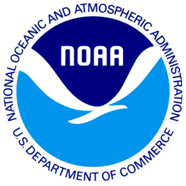
Hurricane Forecast 2010
[As of December 9, 2009] We foresee an above-average Atlantic basin tropical cyclone season in 2010 and anticipate an above-average probability of U.S. and Caribbean major hurricane landfall. Although these early December forecasts have not shown recent-year real-time forecast skill, we believe our new early December forecast scheme will begin to demonstrate forecast skill in the coming years. http://hurricane.atmos.colostate.edu Philip J. Klotzbach and William M. Gray |
|
|
Brown: Earthquake Intensifies Haiti Suffering
Miami firefighter, paramedic and rescue technician Lloyd Brown was asked by Humane Society International (HSI) to join a small team to visit Haiti following the catastrophic magnitude 7.0 earthquake that struck the island nation at 4:53 p.m. on January 12th. Brown arrived with the group on the 21st and spent most of his time in the southern sector of the nation in the vicinity of the quake’s epicenter.
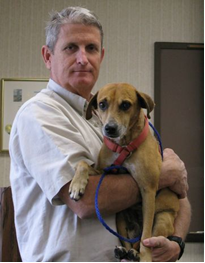 Lloyd Brown with rescued Haitian dog that he named Jean-Luc.
Lloyd Brown with rescued Haitian dog that he named Jean-Luc.By way of background, the epicenter was near the town of Leogane, 16 miles west of Port-au-Prince, the capital city. A dozen days after the primary quake, at least 52 significant aftershocks measuring 4.5 or greater had been recorded. Estimates of people seriously affected are as high as three million, one-third of the population. The Haitian government reports that nearly 225,000 people are dead, another 300,000 injured, a million are homeless and with 30,000 businesses damaged commerce in this perpetually poverty-stricken nation has come virtually to a halt.
For a more complete description of Brown’s work in Haiti please check the Minutes of the Advisory Board meeting of March 3rd which are available through the SART web site at www.flsart.org/SART/login. Additional information about the Haiti situation and the visit by Brown and the HSI team is available through the HSI web site at www.hsus.org/hsi/disaster_services/reports_from_the_field.
[top]
SART Advisory Board Meeting
SART’s Advisory Board met at the Florida Farm Bureau building in Gainesville on March 3rd and the minutes of that meeting are, of course, available through the SART web site at www.flsart.org/SART/login. Issues covered and discussed are covered in the minutes, and include:
 Florida ESF-17 Joe Kight (l) with Advisory Board visitors John and Sandy Dickerson.
Florida ESF-17 Joe Kight (l) with Advisory Board visitors John and Sandy Dickerson.
- FSA’s Tim Manning passing his co-chair duties to David Perry.
- Haiti animal briefing by Lloyd Brown (see above)
- The 2010 Governor’s Hurricane Conference Monday-Friday, May 23-28 in Ft. Lauderdale (www.flghc.org) and SART’s opportunity on the program.
- The April 24-25 training weekend, one day of classroom and one day of field exercise, planned for Sumter County. For more information contact David Perry (perryda@doacs.state.fl.us) or John Haven (havenj@vetmed.ufl.edu).
-
John Haven said that 100-125 people are expected to participate: personnel from FDACS, the Vet Corps, Florida DART, ASPCA, EARS, HSUS and more.
1. Day one is eight-hours of awareness-level Basic Responder training in the classroom.
2. Day two is a hands-on field exercise based on a flood simulation. Animal volunteers are available. (Individuals will simulate distressed owners who have been separated from their pets, giving participants a taste of real in-the-field situations.) - Suzan Loerzel discussed animal carcass disposal issues and progress of the working group.
- SART planner Michael Turner presented the written document for SART organization. It was approved by those present and sent to the Steering Committee for a final vote. (The FLSART Organizational Declaration was subsequently approved by the Steering Committee on March 10th.)
- Michael Turner and Joe Kight presented their developing plan for a 2011 SART Conference tentatively set for the Hilton University of Florida Conference Center [1714 SW 34th Street, Gainesville (352) 371-3600] in late February-early March. The plan is to eliminate registration fees for the conference!
Photos from the Steering Committee Meeting |
||
 |
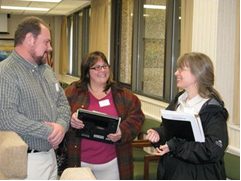 |
 |
| Paul Studivant - Laura Bevan | Tony Duffiney, Kim Duffiney, Sue Loerzel | Vice Chair David Perry |
[top]
Strained Economic Times in Pasco and Hillsborough
Dr. Terry Spencer, DVM, formerly the staff veterinarian of Pasco County Animal Control, is now with the Humane Society of Tampa Bay (HSTB) www.humanesocietytampa.org. Terry says the number of people needing assistance with food and vaccinations for their pets has increased dramatically. In response to the need, HSTB operates a superbly interactive web site and has tapped its volunteers for additional effort. It also manages a food cupboard for pets named for Casper, the white pit bull which was rescued from an abusive home last year (and whose owners are now facing jail time).
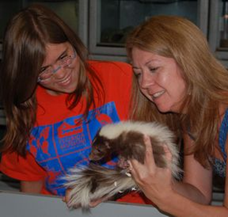
A sobering statistic from HSTB:
There are 200,000 feral cats in Hillsborough County. In 2007, the county euthanized 26,727 animals, which is actually down from a high of 30,262 in 2004-05, but 16,950 were cats. In response to this startling number, HSTB suggests that Trap-Neuter-Return (or TNR) is the only effective method to humanely manage and reduce feral cat colonies. TNR respects a feral cat’s wild state and allows it to live out its life comfortably.
And in Hillsborough County:
Hillsborough County Animal Services www.hillsboroughcounty.org/animalservices faced 2009 budget cuts that would eliminate 26 positions and deeply diminish core missions of public safety, animal adoptions and preventing animal cruelty (dog fighting, puppy mills and other cases of cruelty, abuse and neglect).
- In response, local supporters lobbied the county commission to raise dog and cat registration fees by $10 per year, enough to save 11 positions. Tag fees had not been raised in 10 years and were lower than in other communities.
- The shelter also raised its boarding fee from $8 to $12 a night.
The department ultimately lost 15 positions and this hit the shelter on Falkenburg Road very hard, says director Bill Armstrong. Today, a hundred volunteers have stepped up and work at the shelter caring for dogs and cats.
Regarding adoption and euthanasia, Armstrong is on record: "You can't adopt or euthanize your way out of the problem," he has said. “We have to continue to get the word out that pet owners must sterilize their pets.”
Of the 1,000 shelters that replied to the National Council's 1997 survey, 4.3 million animals were handled.
- In 1997, roughly 64 percent of the total number of animals that entered shelters were euthanized -- approximately 2.7 million animals in just the 1,000 responding shelters. These animals may have been euthanized due to overcrowding, but may also have been sick, aggressive, injured or suffering from something else.
- 56 percent of dogs and 71 percent of cats that enter animal shelters are euthanized. More cats are euthanized than dogs because they are more likely to enter a shelter without any owner identification.
- Only 15 percent of dogs and 2 percent of cats that enter animal shelters are reunited with their owners.
- 25 percent of dogs and 24 percent of cats that enter animal shelters are adopted.
It is estimated that approximately 3.7 million animals were euthanized in the nation’s shelters in 2008.
Source www.AmericanHumane.org
And finally, this note from Sherry L. Silk, Executive Director, Humane Society of Tampa Bay:
In 2008, because so many people were relinquishing their pets to the Humane Society of Tampa Bay, due to the poor economy, HSTB started several programs aimed at helping people keep the pets that they love.
1. First we started a food assistance program. Anyone who needs help feeding their dogs or cats can come for a free bag of food. We didn’t want animals in Hillsborough County to go hungry just because their owners had lost their job. This program was recently renamed “Casper’s Cupboard.” Casper is a purebred white boxer who was almost starved to death in Hillsborough County. HSTB fostered this dog while he healed and later found him a home. This dog has become the poster child for cruelty to animals in our area.
2. Then we then held free shot clinics in disadvantaged neighborhoods so that people could keep their pets vaccinated. Not only does this keep animals healthy, it keeps the public safe as well since rabies shots are given. We work hand in hand with Hillsborough County Animal Services to pick out the neediest neighborhoods for these clinics and they actually give out free licenses to the folks who attend.
3. We also opened an affordable wellness clinic for the public so that people can bring their pets to see a veterinarian for preventative care and sickness. These programs have kept thousands of animals with their owners, rather than being turned in to a shelter.
[top]
WIFSS Course Reminders
Courses offered by WIFSS in cooperation with FDACS that are still available for March are:
- AWR-154 Principles of National Incident Management System (NIMS), Team Building, and Risk Communication
- Tuesday, March 30 – 8:00 am to 4:30 pm at the Palm Beach County, Division of Emergency Management, 20 South Military Trail, West Palm Beach, FL 33415
- Wednesday, March 31 – 8:00 am to 4:30 pm at the Institute of Public Safety (Building 22, Room 155) Broward College Central Campus, 3501 SW Davie Rd, Davie, FL 33314
- Core concepts of the ICS, NIMS, and risk communication, weapons of mass destruction (WMD) and methods of dissemination
- NIMS as an all-hazards, and comprehensive approach to collaborative incident management.
- Using ICS to coordinate the efforts of multiple agencies
- Basic principles of interagency teamwork, communication, and conflict management
- Understanding of the importance of effective internal and external communications
- Emergency responders, supervisors and managers, law enforcement officers, fire/rescue, EMS and OES
- Federal, state & local public health and environmental health agencies
- Hospital clinicians, administrators, health care providers
- Environmental health and public information officers
- Agriculture industries, including cultivation, processing, distribution, storage, transportation, veterinarians and extension advisors
- Elected or appointed public officials
CONTENT INCLUDES |
SUGGESTED ATTENDEES |
Registration: http://wifss.ucdavis.edu/agroterrorism/classes/classesbydate.php
Information: http://wifss.ucdavis.edu/agroterrorism/classes/course_desc.php
Contact John Terry (850-410-6756 or terryj1@doacs.state.fl.us ) with questions.
Please remember that all courses are free of charge with lunch provided, thanks to a DHS grant through WIFSS. Additional sponsoring partners include IFAS-Extension, the Department of Health and the Regional Domestic Security Task Forces.
And Now...Giant Snails!
In 1966, a boy smuggled three giant African snails (gAs) into Miami. His grandmother released them. Seven years later, there were 18,000+. Ten years and a million dollars later, they were eradicated. It’s the only known successful snail eradication.
According to a recent FDACS press release, giant African snails are a serious plant pest and potential threat to public health, indeed they could cause a “giant swath of destruction.” It is illegal to import gAs without a permit and no permits have been issued.
- They eat at least 500 different types of plants.
- They cause damage buildings by eating plaster, stucco and other calcareous materials to grow shells.
- They carry parasites and are thereby a health concern. (Use gloves when handling snails and wash your hands thoroughly afterward.)
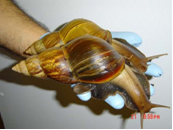
The gAs is enormous…for a snail: up to 8 inches long and 4 ½ inches in diameter with a brownish shell. They can live nine years and a single snail contains both female and male reproductive organs. In a year, it lays about 1,200 eggs. Originally from East Africa, gAs is present on the Caribbean islands of Martinique, Guadeloupe, St. Lucia and Barbados.
Anyone who thinks they have seen a giant African snail, or may have information on illegal snail smuggling or import activity, is asked to please call the Department's toll-free helpline at (888) 397-1517. For information visit http://www.fl-dpi.com.
[top]
Featured Web Site
www.zooanimalhealthnetwork.org
Since 2000, the Lincoln Park Zoo Davee Center for Epidemiology and Endocrinology in Illinois has coordinated efforts among the members of Association of Zoos and Aquariums (AZA: www.asa.org) to test and/or monitor for zoonotic diseases.
The first project was a voluntary, passive surveillance effort collecting data on tuberculosis testing of exotic hoof stock. This was the first project to incorporate on-line recording of data for monitoring purposes.

Jaguar at Jacksonville zoo
The second, larger effort was surveillance and monitoring for West Nile virus. Funded by the Centers for Disease Control (CDC), it was proof of the concept that novel zoo data could be combined with national surveillance systems, adding robustness to these systems with a layer of animal data previously not captured.
Prior to these projects, infrastructure to conduct national surveillance didn’t exist. USDA APHIS Animal Care (AC) realized the value of supporting this effort and recruited AZA to assist with policy development.
-
- The majority of emerging and re-emerging human diseases are zoonotic in nature.
- Monitoring wildlife health is a practical means for early identification of disease events.
- Surveillance in wild populations presents logistical difficulties.
- Many obstacles can be overcome by using zoos as disease sentinels.
- Zoos have stable animal population whose health is regularly monitored and recorded. This provides valuable medical information and allows for serial; sampling of individuals and groups over time.
- Zoos host a broad range of species, each with their own susceptibilities. This allows testing for an array of disease agents.
- Zoos offer geographic distribution. With more than 200 AZA accredited institutions, zoos can be found in 47 states, spanning urban, suburban, and rural; environments across the country.
- As sites of increased human-animal interaction, zoos provide a unique opportunity to monitor for zoonotic diseases.
- The majority of emerging and re-emerging human diseases are zoonotic in nature.

Polar bear at Lincoln Park Zoo
The Zoo Animal Health Network is based at Lincoln Park’s Davee Center. Anticipating the growing risk of avian influenza, Newcastle disease, chronic wasting disease, foot and mouth disease, monkey-pox and others, Lincoln Park and USDA developed this network to monitor for emerging diseases. ZAHN is an early warning system to the nation’s animal health center, identifying these diseases should they emerge in zoo populations.
For questions contact Dr. Yvonne Nadler, Illinois Project Manager, Zoo Animal Health Network, Davee Center, Lincoln Park Zoo, 2001 N Clark St., Chicago IL 60614 (312) 742-2250 or ynadler@lpzoo.org.
[top]
Center for Domestic Preparedness Recognizes Trainers
The Center for Domestic Preparedness in Anniston, Alabama annually recognizes individuals through an “Excellence in Training” program. At their Silver Level, they recently gave a shout out to Arlene Crow of the Dept. of Health in Orlando.
Arlene is assigned to the Orange County Health Department in Orlando. She is a member of a six-person Emergency Operations team that plans for and responds to any disaster event – natural or terrorist-related – that affects public health. She is the team’s Emergency Response Coordinator and lead instructor.
Before beginning her career with the State of Florida, Arlene served as a firefighter/EMT for the city of Lakeland. She is a member of the Central Florida Regional Domestic Security Task Force and a member of the Region 5 Type III Incident Management Team. Arlene is an authorized trainer for FEMA and DHS. She also has overseas training experience having taught Incident Command to medical personnel at the U.S. Naval Base in Bahrain. Arlene holds a Bachelor's degree in Organizational Management, and is currently working on two Master's Degrees: one in Emergency & Disaster Management and the other in Homeland Security.
[top]
Florida Agriculture Quick Quiz
How well do you know the state of agriculture in the Sunshine State?
If you answer half of these questions correctly, award yourself one Green Thumb.
Get them all right and we’re in awe. Gold plate that Green Thumb!
Feel free to look them up as you go!
Our source is www.florida-agriculture.com/agfacts.htm
(Answers at end of this month’s Sentinel.)
1. In the most recent year reported, 2005, Florida had __________ commercial farms. [Choose the closest answer: 5,117, 42,500 or 204,981.]
2. In 2005, approximately how many acres were in Florida farmland? [Choose the closest answer: 10,000,000 acres, 50,000,000 acres or 386,000,000 acres?]
3. Average farm size in Florida is about __________ acres. [Choose the closest answer: 235, 1,000, 3,750.]
4. What product group brings in the most money to Florida farms? [Choose the closest answer: citrus, vegetables and melons, foliage and floriculture.]
5. How many trees are planted in Florida each year? [Choose the closest answer: 150,000, 1-2 million, 85 million.]
Bonus: More than 140 countries imported Florida agricultural commodities in 2004. Which countries were the leading importers?
[top]
Safety News & Notes from the Field
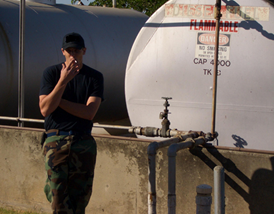 What we have here is a failure to communicate. |  |
The tank (left photo) contains diesel fuel for backup power generators at an Air Force communications site in California. The airman shown blissfully puffing away had “completed all mandatory safety briefings,” our contributor explains. “He is no longer in the Air Force.” Not sure if that was a direct result or incidental, but if the former, no wonder. Our second little tableau was at a gas station in Arizona. “When I asked the employees about the thought process” behind this ash-tray location, they replied, "We have to smoke 20 feet from the front door. It’s 20 feet away." Which begs the question, 20 feet away from what? All that the airman or the gas-station employees need to do is torch off a major fireball, and then they’ll really find out one way that smoking is bad for you. Naval Safety Center www.safetycenter.navy.mil |
|
[top]
About the SART Sentinel |
Editor: Rick Sapp, PhD, Technical Writer, Florida Department of Agriculture & Consumer Services, Division of Animal Industry [rsa5@cox.net] Associate Editor: Joe Kight, State ESF-17 Coordinator, Florida Department of Agriculture & Consumer Services, Division of Animal Industry [kightj@doacs.state.fl.us] The SART SENTINEL is an E-mail newsletter prepared monthly by Rick Sapp and the members of the Florida State Agricultural Response Team. Past issues of the Sentinel are archived on the Florida SART Web Site, www.flsart.org. If you have a story or photo that you would like to have considered for publication in The SART SENTINEL, please contact the Editors. [top]Answers to Florida Agriculture Quick Quiz1. According to FDACS Florida had 42,500 commercial farms in 2005 Source: www.florida-agriculture.com/agfacts.htm [top] |

